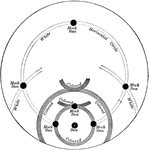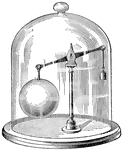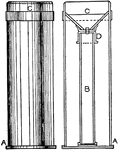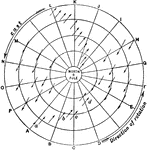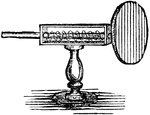The Meteorology ClipArt gallery offers 103 illustrations of weather, air currents and patterns, and meteorological tools.

Mountain Temperature
The diagram shows the effect of the sun's rays on the increased temperature of the mountain compared…

Abbe's Marine Nephoscope Horizontal Compass Projection
Abbe's Marine Nephoscope for observing direction and motion of a cloud. The horizontal mirror reflects…
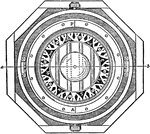
Abbe's Marine Nephoscope Horizontal Mirror Projection
Abbe's Marine Nephoscope for observing direction and motion of a cloud using a compass. The compass…
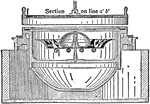
Abbe's Marine Nephoscope Inside View
The inside view of Abbe's Marine Nephoscope used to measure the cloud's direction and velocity on a…

Marvin's Nephoscope
Marvin's Nephoscope to measure direction and velocity of the cloud. This nephoscope is used on land,…
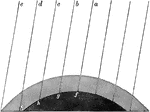
Oblique Rays
The vertical rays are spread over a smaller area, and pass through a thinner layer of air. The vertical…
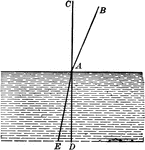
Atmospheric Optics
"BA is the ray of light passing through a rare medium (as, for instance, air); and upon its entrance…

Atmospheric Optics
The figure "illustrates the bending of the solar rays entering the atmosphere. When the sun is below…

Origin of Winds
Winds are masses of air in motion. They resemble the currents in the ocean, and result from the same…
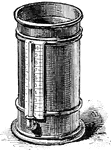
Pluviometer
An instrument for collecting and measuring the quantity of water that falls in rain, snow, etc.
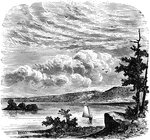
Primary Forms of Clouds: Cirrus and Cumulus
Cirrus cloud is a type of cloud composed of ice crystals and characterized by thin, wisplike strands,…
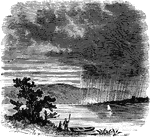
Primary Forms of Clouds: Nimbus and Stratus
A Nimbus, or Storm Cloud, is any cloud from which rain falls. The Stratus, or Layer Clouds, form in…

Psychometer
An instrument for determining the tension of the aqueous vapor in the air or the relative humidity.

Psychrometer
The psychrometer (showing wet and dry bulb thermometers) is an instrument used for determining the humidity…

Rain Gauge
"A Rain Gauge is an instrument or contrivance for measuring the amount of rain which falls on a given…

Rain Gauge
An instrument or contrivance for measuring the amount of rain which falls on a given surface. They are…

Rain Gauge
"This is an instrument designed to measure the quantity of rain which falls at any given time and place."…
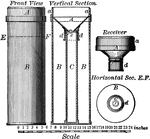
Rain Gauge
"Rain gauges are usually vertically placed sheet-metal hollow cylinders of from 5 to 8 inches in diameter.…
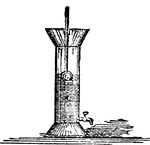
Rain-gauge
An instrument for measuring the quantity of rain that falls at any given place in a given time.

Hand Powered Marvin Weather Kite Reel
A Marvin weather kite reel powered by hand. The reel keeps record of the direction and intensity of…
Regnaults Hygrometer
"It consists of a glass tube or capsule A, having on the bottom and a little way up a highly polished…

Rotary Theory of Hail
The wind is supposed to rotate as in a cyclone, only the axis of the whirl is horizontal instead of…

Secondary
"In meteorology, a subsidiary cyclonic circulation, generally on the border of a primary cyclone accompanied…
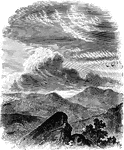
Secondary Forms of Clouds
Cirro-Cumulus is formed from cirrus or cirrostratus clouds when they are warmed gently from below. Cirro-Stratus…
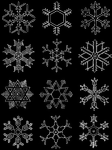
Snowflakes as Described by William Scoresby
"The aqueous vapor of the atmosphere precipitated in a crystalline form, and falling to the earth in…

Line squall
"The warmer current ascends, as indicated by the small arrows, and curls at the black wreath (u) of…

Sun Rays
It is hotter at noon than at sunrise and sunset because there is a greater thickness of air for the…
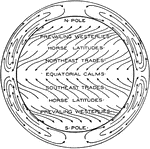
Terrestrial Winds
"The prevailing winds of the globe; with a section of the atmosphere showing its system of permanent…
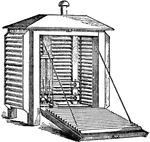
Thermometer Box
"Stevenson's louvre-boarded box for the thermometers, which is now very widely used for temperature…
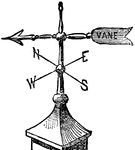
Vane
A fixture attached to some elevated object for the purpose of showing which way the wind blows.

Arrow Wind Vane
"The horizontal direction of the wind is usually observed by means of an instrument called the arrow…

Wind Movement
The image "shows the path of a body starting northward from any point O in the northern hemisphere and…
